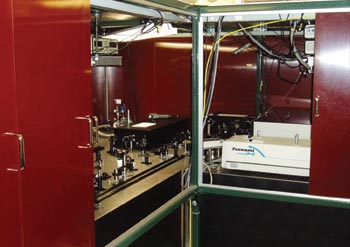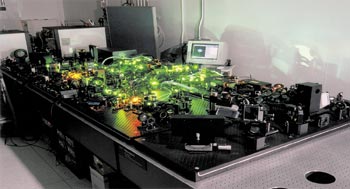The enclosure is an important part of laser safety.
Ken Barat, Lawrence Berkeley National Laboratory
Commercial lasers are designed in protective cases that ensure that the beams emerge only from designated apertures, and the typical laser laboratory is protected by interlocked doors and outside warning lights. Between these two levels of laser safety is the enclosure, a box constructed around the laser(s) and all other components on the optical bench. It’s one of the best tools for providing laser safety.
Ironically, enclosures usually are constructed for reasons other than laser safety. One explanation may be to shield the experiment from room lights, or to prevent air drafts from perturbing delicate beam paths. Nonetheless, an enclosure around an entire experiment provides significant protection against optical accidents.

This optical table is totally enclosed by a sliding-panel system, independent of the table itself.
One word of caution, though, about enclosures intended for cleanliness or for shielding the experiment. They often are constructed of plastic or acrylic and appear opaque at visible wavelengths. But if you’re working with a neodymium or ytterbium laser, or with any other that emits in the infrared, that acrylic material may be transparent at those longer wavelengths.
The majority of enclosures in use today are homemade, resulting in a wide variety of construction methods and materials — and in different degrees of laser safety. But some commercial firms manufacture and sell enclosures or offer enclosure kits. The ANSI Laser Committee recently provided new guidance on enclosures in the form of its Z136.4 “American National Standard for Testing and Labeling of Laser Protective Equipment.” It includes a section on testing and labeling requirements for barriers and enclosures.

An optical table with no enclosures or other protection requires all personnel in the room to don safety eyewear.
A question I frequently encounter is whether an enclosure around a Class 4 laser must be interlocked. While ANSI Z136.1 “Safe Use of Lasers — 2007” provides clear options for room-access controls, the picture is less clear for experimental enclosures. The standard states, “If a user-created enclosure does not meet the requirements of a protective housing (e.g., a noninterlocked cover), it shall be considered as a barrier or curtain, and other controls are required per Section 4.3.1.1.” Section 4.3.1.1. discusses administrative and procedural controls, education and training but leaves somewhat ambiguous the question about interlocks on enclosures.
As a practical matter, though, experimental enclosures usually are not interlocked (i.e., like a kitchen cabinet, free to swing open). Some of them require a special tool to open, a technique that’s used particularly when ionizing radiation exists within the enclosure. On the other hand, in nonexperimental settings, and particularly with industrial systems, interlocked enclosures are the general rule.
There are three broad approaches to building an enclosure around a laser setup. The first is total enclosure — a frame that fits around the entire setup and provides sliding panels to enable access to it. These enclosures often are made with aluminum framing, and the top can be open, or there can be air filters or even lighting installed in the top.
A second type is a system of movable walls around the setup, often with feet that fit into holes around the perimeter. These are akin to large beam blocks surrounding the experiment (a perimeter guard). They should be higher than any beam that could possibly emerge from the table, but they should not be so high that they block convenient access.
A third approach is a compartmentalized enclosure that breaks the experiment into separate zones of access. This has several advantages. If more than one wavelength is present in the experiment, the compartments can segregate them so that the eyewear requirements are less restrictive. Also, opening a small compartment is less likely to disturb the experiment than is opening the whole enclosure.
In summary, let me repeat: An enclosure is one of the best tools for providing laser safety.
Meet the author
Ken Barat is the laser safety officer at Lawrence Berkeley National Laboratory in Berkeley, Calif.; e-mail: kbarat@lbl.gov.
/Buyers_Guide/Lawrence_Livermore_National_Laboratory/c8307